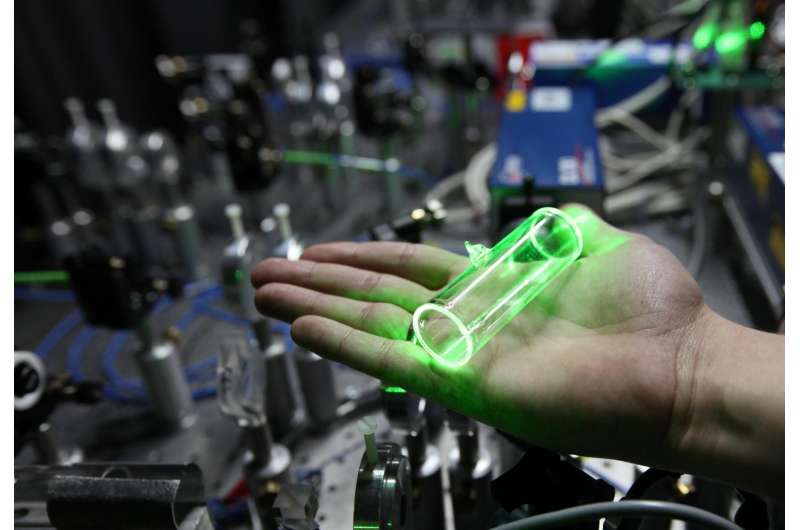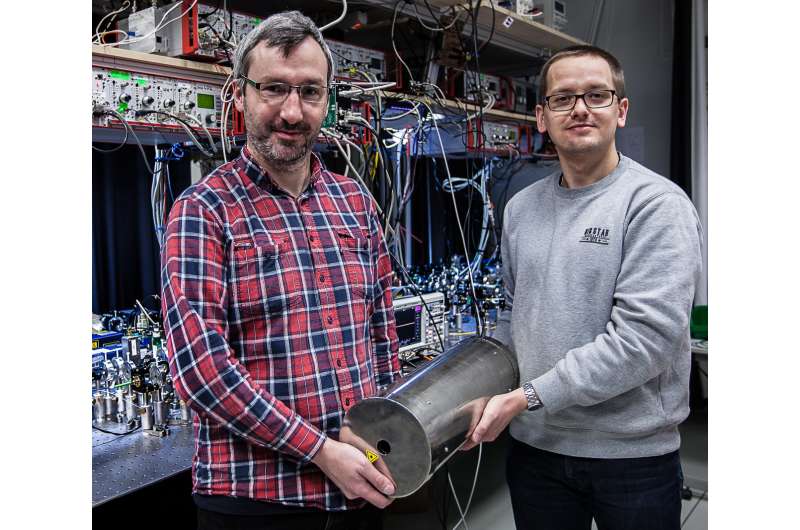Large groups of photons on demand—an equivalent of photonic 'integrated circuit'

Physicists from the Faculty of Physics at the University of Warsaw have developed a holographic atomic memory device capable of generating single photons on demand in groups of several dozen or more. The device, successfully demonstrated in practice, overcomes one of the fundamental obstacles towards the construction of a quantum computer.
Completely secure, high-speed quantum communication and quantum computing are among the possible applications for this new source of single photons. It is the first device that enables the on-demand production of a precisely controlled group of photons, as opposed to just a single one.
"Compared to existing solutions and ideas, our device is much more efficient and allows for integration on a larger scale. In the functional sense, one can even think of it as a first equivalent of a small integrated circuit operating on single photons," explains Dr. Wojciech Wasilewski (UW Physics), one of the authors of an article published in Physical Review Letters.
The first single-photon sources were invented in the 1970s, and even though the many types that exist today still have many drawbacks, single photons are successfully used in quantum communication protocols that guarantee full confidentiality. However, to be able to perform complex quantum computations requires groups of photons.
The simplest method of generating groups of photons is to use a sufficiently large number of sources. Current devices exploit the phenomenon of spontaneous parametric down-conversion (SPDC). Under certain conditions, a photon generated by a laser can split into two new ones, each with half the amount of energy, and with all other properties linked by the principles of conserving energy and momentum. Thus, when information is encoded on one of the photons from the pair, the properties of the other photon are known, which nevertheless remain undisturbed by observation and therefore perfectly suitable for quantum operations. Unfortunately, every SPDC source generates single photons slowly and quite randomly.
In 2013, a team of physicists from the Universities of Oxford and London proposed a much more efficient protocol for generating groups of photons. The idea was to place a quantum memory at each source, which would be capable of storing emitted photons, which could then be released at the same moment. Calculations showed that the time scale required to emit a group of 10 photons would be shortened by a whopping 10 orders of magnitude—from years to microseconds.

The source developed by the University of Warsaw physicists represents the first implementation of this concept. Here, all the photons are created immediately within the quantum memory as a result of a laser pulse that lasts only microseconds. External sources of single photons are no longer required, and the necessary number of quantum memories is reduced to just one.
"Our entire experimental setup takes up about two square meters of our optical table surface. But the most important events take place in the memory itself, in a glass cylinder measuring approximately 10 cm in length and with a diameter of 2.5 cm. Anyone who might expect to see inside the cylinder a sophisticated design will be greatly disappointed: The interior of the cell is filled only with pairs of rubidium atoms 87Rb at 60 to 80 degrees Celsius", says Michal Dabrowski, a Ph.D. student at UW Physics.
The device is a spatially multimode memory: Individual photons can be placed, stored, processed and read in different areas inside the cylinder, acting as separate memory drawers. The write operation, performed with a laser beam, works by preserving a hologram in the form of atomic excitations. Illuminating the system with the laser allows researchers to reconstruct the hologram and read the memory's content.
In the experiments, the new source generated a group of up to 60 photons. Calculations show that in realistic conditions, the use of higher-power lasers could increase this number up to several thousand. (The calculations involved in the data analysis from this experiment were of such great complexity that they required the computing power of 53,000 grid cores of the PL-Grid Infrastructure).
Due to noise, losses and other parasitic processes, the quantum memory from UW Physics can store photons from several to tens of microseconds. Though this period seems insignificant, there are systems allowing for simple operations to be performed on photons in nanoseconds. In the new quantum memory, researchers can, in principle, perform several hundred operations on each photon, which is sufficient for quantum communication and information processing.
Having such a working source of large groups of photons is an important step toward constructing a type of a quantum computer able to perform calculations in much less time than the best modern computing machines. Several years ago, it was shown that performing simple linear optics operations on photons can increase the speed of quantum computing. The complexity of these computations depends on the number of photons processed simultaneously. However, the limitations of the sources of large groups of photons prevented linear quantum computer development, limiting them to elementary mathematical operations.
In addition to quantum computations, the photonic integrated circuit may be useful in quantum communication. Currently, this involves sending single photons using an optical fibre. The new source would allow many photons to enter the optical fibre simultaneously, and therefore would increase the capacity of quantum channels.
More information: "High-Capacity Angularly Multiplexed Holographic Memory Operating at the Single-Photon Level"; R. Chrapkiewicz, M. D?browski, W. Wasilewski; Physical Review Letters 118, 063603 (2017) DOI: 10.1103/PhysRevLett.118.063603
Journal information: Physical Review Letters
Provided by University of Warsaw



















